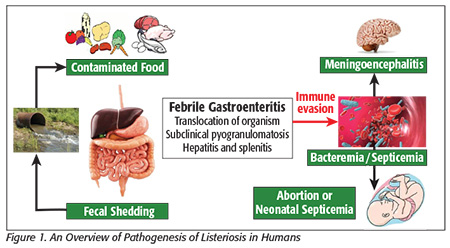The advancement of hurdle technologies that combine existing or/and novel preservation techniques to prevent the growth of microorganisms and increase the shelf life of products has enabled food manufacturers to garner substantial consumer confidence. But it wasn’t long before even such quasi-successful endeavors began to cast a shadow of concern on the commercialization of food with extended shelf lives. Since the advent of ready-to-eat (RTE) foods, there has been an increase in their consumption, as well as rapidly emerging reports of health issues associated with these items.
Contamination during any phase of food processing may result in a plethora of adverse health conditions, ranging from an innocuous flu to complications as severe as neonatal septicemia and, in certain cases, even death. One of the rising concerns with the ingestion of RTE foods was highlighted by an illness outbreak in Canada in 1981. Contaminated coleslaw was found to be at the heart of the epidemic. The statistics were alarming, demonstrating a mortality rate of around 27 percent, the highest rate ever reported for an infection by any foodborne pathogen. This outbreak initiated an avalanche of research to discover the causative agent, and the results indicated Listeria spp. Since then, sporadic outbreaks of Listeria monocytogenes have continually caused extremely serious, invasive and often life-threatening foodborne disease with a high economic burden to both public health services and the food industry in the form of recalls.
A Closer Look at Listeriosis
Listeriosis is an important foodborne bacterial zoonosis, with most cases predominantly associated with the pathogenic species L. monocytogenes. The organism is a Gram-positive intracellular bacterium and is considered a microbial wolf in sheep’s clothing, as it is most commonly found as a saprophyte but may cause lethal disease that most often affects the uterus during pregnancy, the central nervous system and the bloodstream. The versatile cocktail of its virulence properties and the potential for biofilm matrix formation enable the bacteria to withstand an array of external stresses, such as an extreme range of temperature (–0.1 to 45 °C), pH (3.0–9.5) and high salt concentrations (up to 10%). This unique ability to withstand such stresses established it as a ubiquitous organism present in a variety of environments, including soil, vegetation and water, where it survives as a saprophyte.
 In animals, the disease causes considerable mortality and economic losses. Listeriosis in animals is also known as silage disease (due to its association with feeding of poorly processed silage) and circling sickness (due to its effects on the central nervous system that can lead to circling movements in the infected animal). Listeriosis is a well-recognized cause of abortion, endometritis, repeat breeding, encephalitis, septicemia and mastitis in animals, arising mainly from the ingestion of contaminated food and water; it is particularly common in ruminants fed contaminated silage.
In animals, the disease causes considerable mortality and economic losses. Listeriosis in animals is also known as silage disease (due to its association with feeding of poorly processed silage) and circling sickness (due to its effects on the central nervous system that can lead to circling movements in the infected animal). Listeriosis is a well-recognized cause of abortion, endometritis, repeat breeding, encephalitis, septicemia and mastitis in animals, arising mainly from the ingestion of contaminated food and water; it is particularly common in ruminants fed contaminated silage.
Infection in humans causes a wide spectrum of illnesses, ranging from febrile gastroenteritis to invasive disease, including bacteremia, sepsis and meningoencephalitis, especially in high-risk patients such as the elderly, immunosuppressed patients, pregnant women and unborn or newly delivered babies. The details of symptoms in various population groups are shown in Table 1, and the pathology of the disease in humans is depicted in Figure 1. While infection can be treated successfully with antibiotics, human infection has a high mortality rate, between 20 and 40 percent.

Routes of Contamination
Consumption of contaminated food is believed to be the principal route of infection in 99 percent of all human cases. However, infection can also be transmitted, albeit rarely, by direct contact with either the environment or infected animals, or by cross-infection between patients during the neonatal period. Hence, the primary intervention to prevent disease is to eliminate or reduce this bacterium from the food processing chain.
Being a ubiquitous bacterium, the organism has the unique ability to easily survive and multiply in a plethora of contaminated food items, such as refrigerated foods like unpasteurized milk and its products (e.g., soft cheese, ice cream and butter), meat, vegetables (e.g., coleslaw salad, vegetable rennet and mushrooms) and various seafoods (e.g., RTE raw mollusks, RTE raw fish and other fish products).
Apart from a wide range of tolerances toward temperature, pH, water activity, salt and nitrite concentrations, along with its tendency to form a biofilm matrix, the survival mechanisms of L. monocytogenes in foods result from a complex series of interactions influenced by the bacterium’s adaptation to the composition of the food, the prevailing food microflora and the conditions of food processing techniques, postprocessing strategies and storage conditions. These factors cumulatively pose a big challenge for the food industry to apply the right combinations of various existing hurdles to prevent this organism from entering the food chain at any point without compromising the quality of the final products. Hence, to ensure that manufactured foods are safe for human consumption, it is essential for food processors to determine conditions that maintain food freshness while keeping microbial contamination at a minimum level. The main checkpoints to prevent the entrance of a pathogen into the meat processing chain are depicted in Figure 2.

Due to Listeria’s significantly high fatality rate and seamless association with everyday food items, it’s become extremely important to keep this organism from entering the food processing chain at all possible stages. To do so, health advice and updated regulations must be aligned. Regulations differ between countries and are dictated by the underlying economy, unmet food demands and the demographics of the population, with the majority of developing nations favoring a risk-based approach. By contrast, a zero-tolerance approach is being followed largely by the United States. What is clear is that any approach must be driven by the science, to protect both public health and the food industry.
Conclusions
The picture portrayed above of Listeria is just a glimpse into its multifaceted pathogenicity and showcases its tremendous potential as a food pathogen. Its unique ability to withstand external stresses with an armor of virulence factors establishes it as a ubiquitous organism present in diverse environments. Since the first major foodborne outbreak of listeriosis in the 1980s, a slew of food companies have endured the brunt of Listeria contamination and paid a dear cost, underscoring its increased relevance in today’s environment. Currently, soft cheeses made from unpasteurized dairy products, delicatessen meats, hot dogs and fresh produce are recognized as the most efficient vehicles for transmission of L. monocytogenes. The populations affected by it underline the need for serious efforts to prevent and control it, and ultimately to reduce huge losses in health, life and monetary terms. Prevention largely resides in undertaking due vigilance during meal preparation (especially thorough washing and proper heating; see “Food-Handling Tips for Consumers”) and the avoidance of high-risk foods by susceptible populations. The insidious nature of this foodborne pathogen, manifested by its ability to survive in difficult environmental conditions, is what actually makes it hard to eradicate and thereby warrants the need to contain this organism from entering the food processing chain at all stages.
Apoorva is a Ph.D. scholar in animal biochemistry at ICAR –Indian Veterinary Research Institute, Izatnagar, India, and can be reached at apoorvashafu@yahoo.com.
Deepthi Vijay, M.V.Sc., is an assistant professor in the College of Veterinary and Animal Sciences, Mannuthy, Kerala, India, and can be reached at deepschinnus@gmail.com.
Pankaj Dhaka is a Ph.D. scholar in the Division of Veterinary Public Health, ICAR – Indian Veterinary Research Institute, Izatnagar, India, and can be reached at pankaj.dhaka2@gmail.com.




